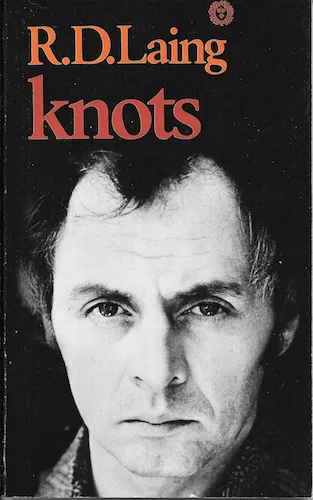

In the field of psychiatry, R.D. Laing is considered something of a big deal. Starting work in 1953 at the Gartnavel Royal Mental Hospital in his native Glasgow, he immediately acquired the title ‘youngest consultant in the country’, and a reputation for his unorthodox psychological beliefs. This was a time when electroconvulsive and insulin coma therapies were still considered cutting edge treatments for mental trauma. Yes, they really are as bad as they sound.
His ‘unorthodoxy’ was that talking therapies, and empathetic, one-to-one doctor/patient relationships were far more effective. Taking patients’ descriptions of their own mental state at face value, rather than treating them as symptoms of some other, underlying illness, which only trained doctors could recognise. Now, of course, these ideas are considered mainstream and practiced in mental institutions the world over. The same cannot be said of all his beliefs, however.
Held up as a figurehead of Western counterculture during the 1960s/70s, he proposed and vigorously defended the idea that ailments such as schizophrenia were not disorders at all. Rather, they were rational reactions to the insane games played by such authoritarian institutions as family, government, and the church.

These games were not of the fun variety. They were a way of explaining how, when presented with various social and political rules (e.g. law, polite conduct, traditional roles, moral and religious codes), human beings competed with one another to turn these rules to their own personal advantage. According to Game Theory, if these rules could be understood, then it was possible to model and predict, mathematically, what happens when two such ‘rational actors’ compete.
By the 1960s, this idea had already gained significant popularity in academic and political circles. Well known experiments such as The Prisoner’s Dilemma made a profound impact on fields as diverse as Economics and Cold War Strategy, and would shape government policy in both for decades to come. Laing’s interest, however, was not so grand. Nor did he buy into the idea that such game playing was in any way rational, or optimal.
He wanted to model games which, he believed, he saw taking place everyday between actual people. Dysfunctional, psychologically unstable people. Whether they be family members, lovers, or even different versions and conceptions of individual selves.

playing a game. If I show them I see they are, I
shall break the rules and they will punish me.
I must play their game, of not seeing I see the game.
One of the results of this period of his thinking was a book of poetry, Knots, the introductory passage of which is quoted above. Laing published a fairly substantial quantity of poetry during his career, however it is perhaps this book alone which crowns his dual contributions to both psychiatry and literature. With that in mind, I don’t think it’s unfair to say that it makes for some pretty strange reading.
At the time of publication and in the years since, there has been some debate as to whether it is even poetry at all. In fact, the edition I have sitting on my desk makes no mention to poetry whatsoever, labelling it ‘psychology’ instead. As I’m sure Laing would agree, these labels ultimately account for very little. Behind the often clinical and logically driven language, there are hints of real people, and real emotional concerns which form the backbone of poetic insight.

Jill and Jack both want to be wanted.
Jill wants Jack because he wants to be wanted
Jack wants Jill because she wants to be wanted.Jill wants Jack to want
Jill to want
Jack's want of her want
for his want of her want ofJack's want that Jill wants
Jack to want
Jill to want
Jack's want of her want
for his want of
her to want Jack to want
Erm, what?
I hear you. Let’s try and break it down.
Jack and Jill are essentially caught in identical loops of needing to be desired, a need which prevents that desire from ever being fulfilled. The first line lays this out clearly enough; they both “want to be wanted”. The second and third lines show that they also both want each other, for the reason that the other also wants to be wanted.
So what’s the problem? Neither of them knows that the other wants them.
So fearful are both of them that their desire will not be matched by the other, they never make the leap of faith that would resolve this fear. Their need to be desired is greater than their need to desire the other person, and so the safest option is to simply want each other’s want in silence. Rather than speak out loud and risk discovering they themselves are not wanted.
A defensive game in which self-interest scuppers the ideal result. The tragedy of romantic desire laid, quite literally, bare.

She has started to drink
as a way to cope
that makes her less able to copethe more she drinks
the more frightened she is of becoming a drunkardthe more drunk
the less frightened of being drunkthe more frightened of being drunk when not drunk
the more not frightened drunk
the more frightened not drunkthe more she destroys herself
the more frightened of being destroyed by himthe more frightened of destroying him
the more she destroys herself
This poem is perhaps a little easier to intuit. Laing presents us with a clear cut depiction of the pathology of addiction, what in everyday language we would call its ‘cycles’. What this poem contributes to its understanding, however - what Laing tries to suggest in almost all these pieces - is that addiction takes place in response to the rules about addiction which society and family impose.
The rules are that being a drunkard is both, A) shameful, and B) destructive. It is precisely because the anonymous ‘She’ is fearful of both outcomes that she drinks in the first place, in order to alleviate that fear. Rather than deter addiction, these rules create the conditions in which drinking becomes a rational response. The action that follows logically and on the surface appears to be in her self-interest.
Hopefully, it should be clear now how these ideas link back to the overarching ones of Game Theory. What the theory presupposed was that rational actors adapted social rules at a comfortable distance, but for Laing, the rules themselves create the actors. By accepting them, and playing along, we accept also the inevitability of certain outcomes. The idea that anyone could remain rational and act in their own interests after prolonged exposure was laughable.

Still, not all of these games have such tragic consequences. This final example from the last section of the book turns to the question of being itself, how linguistic and physical rules determine the way we conceive of ourselves in relation to the universe. The result is profoundly spiritual. Here, irrationality is not something to be feared, but rather embraced.
I am doing it
the it I am doing is
the I that is doing it
the I that is doing it is
the it I am doing
it is doing the I that am doing it
I am being done by the it I am doing
it is doing itOne is afraid of
the self that is afraid of
the self that is afraid of
the self that is afraid
One may perhaps speak of reflections
If the rules themselves defy logic, then what hope do we have of ever coming to a logical conclusion? We are, ultimately, illogical creatures, and if we play at trying to rationalise the universe, it is only because we feel emotionally that there is still some game to be won. A new field of knowledge to dominate. Yet it is clear; self-interest has no context in these grander, transcendent rules. Even the simple attempt to locate ourselves as individuals is shown up as ridiculous. For Laing, the game of reality has no real players, no ‘rational actors’ to speak of.

